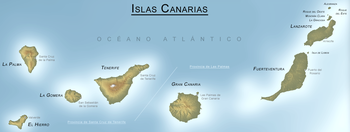Listan Prieto
Listán Prieto (not to be confused with Listán Negro) is a red grape variety that is believed to be originated from the Castilla-La Mancha region in Spain. Listán Prieto has disappeared from Spain mainland, but there are still 29 ha planted on the Canary Islands in 2008.[1]
In 2007, DNA fingerprinting done by the Centro Nacional de Biotecnología in Madrid, Spain discovered that the Mission grape that was widely planted in the earliest New World vineyards in the Americas was a genetic match to Listán Prieto.[2] Despite the genetic match, there is enough clonal variation that has occurred over the centuries of geographical separation that the Mission grape of the Americas and the Listán Prieto grape of the Canary Islands are classified by the Vitis International Variety Catalogue as two separate grape varieties.[3][4] Part of the variation is likely because some of earliest plantings by the Spanish missionaries were from grape seeds[5] which are the result of pollination and sexual propagation and thus more likely to have slight differences from the parent vine than propagation through cuttings.[6]
History[edit]

It is thought that Listán Prieto was widely planted in the Castile region during the 16th century. Settlers to the Canary Islands brought the vines with them and eventually Listán Prieto made its way to the Spanish colonies in Mexico and Peru.[2] From there, the grape spread throughout North and South America where it developed clonal variations that became grape varieties that are now known as Mission in California and Mexico, País in Chile and Criolla Chica in Argentina.[7]
Synonyms[edit]
Principal synonyms include: Criolla Chica, El Paso, Hariri, Listrão, Misión, Mission's Grape, Negra Antigua, Negra Corriente, Negra Peruana, País, Palomina Negra, Rosa del Perú, Uva Chica negra, Uva Negra, Uva Negra Vino, Uva Tinta, Viña Blanca, Viña Negra. Listán Prieto is often mistaken for Jacquez, Listán Negro and Negramoll.[1] It can also be confused with Moscatel Negro, as Spanish Missionaries often planted it alongside Listán Prieto as they established their missions.[8]
References[edit]
- ^ a b J. Robinson et.al. Wine Grapes, A complete guide to 1,368 vine varieties, including their origins and flavours, pp. 550–552 Pinguin Books 2012 ISBN 978-1-846-14446-2
- ^ a b Alley, Lynn (February 2007). "Researchers Uncover Identity of Historic California Grape: Spanish researchers solve mysteries surrounding the Mission variety and viticulture throughout the Americas". Wine Spectator Online. Archived from the original on March 25, 2008. Retrieved December 27, 2010.
- ^ VIVC "Mission entry Archived 2012-05-13 at the Wayback Machine" Accessed: December 27th, 2010
- ^ VIVC "Listan negro Archived 2012-05-13 at the Wayback Machine" Accessed: December 27th, 2010
- ^ A. Bespaloff Complete Guide to Wine, pp. 191–194 Penguin Books 1994 ISBN 0-451-18169-7
- ^ J. Robinson (ed) "The Oxford Companion to Wine" Third Edition, p. 729 Oxford University Press 2006 ISBN 0-19-860990-6
- ^ J. Robinson Jancis Robinson's Guide to Wine Grapes, pp. 97 & 111 Oxford University Press 1996 ISBN 0-19-860098-4
- ^ "Researchers Uncover Identity of Historic California Grape | News | News & Features | Wine Spectator". WineSpectator.com. Retrieved 2019-01-24.
